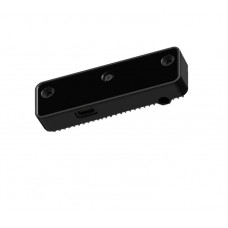OAK-D-Lite Fixed Focus, OpenCV AI Machine Vision Kit, Depth Measuring, Image Recognition
Overview : OAK-D-Lite takes the affordability idea and pushes it one step forward. By having the same SpatialAI functionality as OAK-D with a smaller weight and form factor, it gives you the opportunity to create all sorts of projects. It is meant to be used by anyone, anywhere. The Swiss Army Knife of Computer Vision.
Hardware Specifications :This OAK camera uses USB-C cable for communication and power. It supports both USB2 and USB3 (5Gbps / 10Gbps).
|
Camera Specs |
Color camera |
Stereo pair |
|---|---|---|
|
Sensor |
||
|
DFOV / HFOV / VFOV |
81° / 69° / 54° |
86° / 73° / 58° |
|
Resolution |
13MP (4208x3120) |
480P (640x480) |
|
Focus |
AF: 8cm - ∞ OR FF: 50cm - ∞ |
Fixed-Focus 6.5cm - ∞ |
|
Max Framerate |
60 FPS |
200 FPS |
|
F-number |
2.2 ± 5% |
2.2 |
|
Lens size |
1/3.1 inch |
1/7.5 inch |
|
Effective Focal Length |
3.37mm |
1.3mm |
|
Distortion |
< 1% |
< 1.5% |
|
Pixel size |
1.12µm x 1.12µm |
3µm x 3µm |
RVC2 inside : This OAK device is built on top of the RVC2. Main features:
4 TOPS of processing power (1.4 TOPS for AI)
Run any AI model, even custom architectured/built ones - models need to be converted.
Encoding: H.264, H.265, MJPEG - 4K/30FPS, 1080P/60FPS
Computer vision: warp/dewarp, resize, crop via ImageManip node, edge detection, feature tracking. You can also run custom CV functions
Stereo depth perception with filtering, post-processing, RGB-depth alignment, and high configurability
Object tracking: 2D and 3D tracking with ObjectTracker node
OAK-D vs OAK-D-Lite : OAK-D-Lite is smaller, lighter and uses less power; compared to OAK-D. The main differences are:
*Mono cameras have lower resolution (640x480 instead of 1280x800)
*There is no IMU (Inertial measurement unit) on the OAK-D-Lite, as most users don’t need it. IMUs are currently hard to come by, so the price increased significantly - and we wanted to lower the price point as much as possible.
*There is no power jack, as most users just used the USB-C for power delivery, which provides 900mA at 5V and is enough for most use-cases. However some functions (e.g. inference, video encoding) can lead to large current spikes, so there is a chance hosts like RPi won’t be able to provide enough power. In that case, you should use Y-adapter.
*Additionally, the more technical differences are the following:
Robotics Vision Core 2 chip-down design, instead of connecting the OAK-SoM` to the baseboard (like it is done on OAK-D)
In collaboration with ArduCam, we developed custom camera sensor connectors, which are shorter and take up less space
Fixed-focus vs Auto-focus : When ordering the OAK-D-Lite, you can select whether you want Fixed-focus (FF) or Auto-focus (AF) on the color camera. You should select FF if you are mounting OAK camera to something that vibrates. You should select AF when you need things closer than ~50cm to be in focus. More information can be found at Auto-Focus vs Fixed-Focus.
Dimensions and Weight :
Width: 91 mm
Height: 28 mm
Length: 17.5 mm
Baseline: 75 mm
Weight: 61 g
 Depth perception : This OAK camera has a baseline of 7.5cm - the distance between left and right stereo camera. Minimal and maximal depth perception depends on camera FOV, resolution, and baseline - more information here.
Depth perception : This OAK camera has a baseline of 7.5cm - the distance between left and right stereo camera. Minimal and maximal depth perception depends on camera FOV, resolution, and baseline - more information here.
Min distance: ~20cm (480P, extended), ~35cm (480P)
Maximal perceiving distance: ~ 19.1 meters
Extended means that StereoDepth node has Extended disparity mode enabled, more information here. Maximum perceivable distance calculation here.
Power consumption
Standby: 0.6 W
Running depthai_demo.py: 4 W
Max consumption: 4.5 W
Occasional power spikes of 2W may occur when running videoEncoder and/or Neural Network. OAK-D-Lite can be also powered off of USB3.
Operating temperature :
We have tested OAK-D-Lite with the following command which should inflict the highest consumption:
python3 depthai_demo.py -enc color -s color left right depth
and after 90 minutes, we received the following temperatures:
Enclosure: 55.7 °C (thermal image below)
Robotics Vision Core 2: 73.53 °C
The operating temperature range of the Robotics Vision Core 2 (die temperature) is -40 °C to 105 °C. The die temperature can get to about +35°C from the ambient temperature. Note that the stable image temperature of the camera sensor is 0 °C to +50 °C (operating temperature -30 °C to +70 °C).

Links Related to OAK-D-Lite Auto Focus : Datasheet
Enter the code in the box below:

